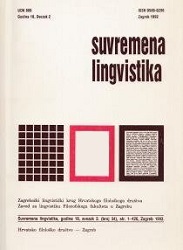Kako izvorni govornici hrvatskoga jezika razumiju druge slavenske jezike? Istraživanje metodom praćenja pokreta oka
How native speakers of Croatian understand other Slavic languages? Visual World Paradigm eye–tracking experiment
Author(s): Jacek Kudera, Josip JagodarSubject(s): Language studies, Communication studies, Western Slavic Languages, Eastern Slavic Languages, South Slavic Languages
Published by: Hrvatsko filološko društvo
Keywords: receptive multilingualism; Croatian language; Slavic languages; visual world eye-tracking paradigm; sentence comprehension; auditory modality;
Summary/Abstract: Speakers of closely related languages have a clear privilege when communicating with one another over speakers of typologically and genetically distant languages. They can use their L1s and conduct a relatively fluent conversation. Such a multilingual interaction is referred to as ‘intercomprehension’. Th e Slavic language family is a good example for testing intercomprehension due to extensive language contact and well documented historical development of each member of the language family. In this paper, we present an experiment in the Visual World Paradigm (VWP) to shed light on the factors facilitating and impeding mutual intelligibility. In a multilingual communication, speech comprehension depends on a degree of similarity between the languages and contextual (un)expectedness of elements coming from a closely related language. To quantify the first factor, we analyze the surface phonetic resemblance between the equivalents of cognate predicates across the Slavic languages; To address the question of stimulus (un) expectedness, we adopt a methodology of information theory. In this study, native speakers of Croatian are exposed to Bulgarian, Czech, Polish, and Russian sentences. Their task is to listen to foreign audio samples and watch the pictures referring to simple SVO–type sentences. We hypothesize that gaze anticipation effect measured on a visual fi eld presenting a direct object is driven by the information theoretic notion of surprisal and phonetic similarity between the predicates in Croatian and a language of exposure. A strong intercomprehension effect was observed for Croatian native speakers listening to Polish sentences. Th e results of the eye–tracking experiment shed light on visually enhanced processing of closely related languages. Th e outcomes of this study contribute to the debate about the factors moderating mutual intelligibility among Slavic speakers.
Journal: Suvremena lingvistika
- Issue Year: 49/2023
- Issue No: 96
- Page Range: 203-223
- Page Count: 21
- Language: Croatian

